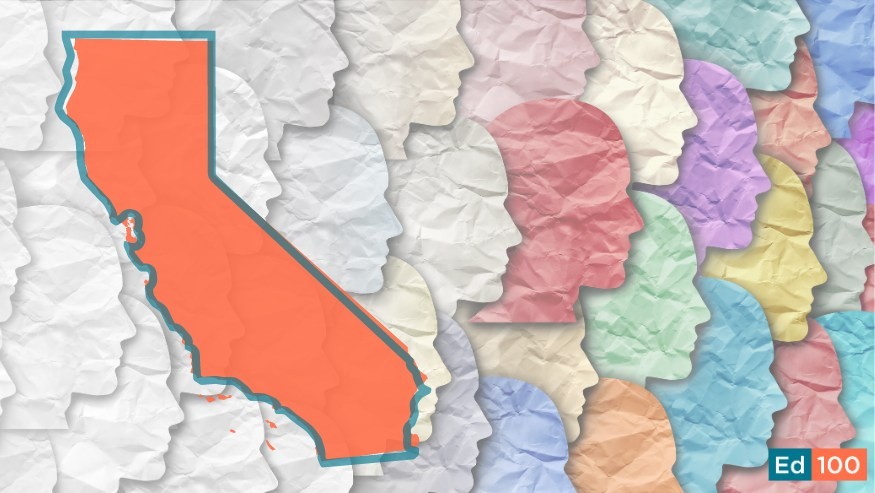The Battle over Ethnic Studies

How should Ethnic Studies be taught?
The 2025-26 school year was slated to be the first year when all California high schools would require students to pass a course in ethnic studies. The requirement lapsed, unfunded in the state budget. This post reviews why schools are no longer required to teach ethnic studies, what the course is about, and the options school districts are grappling with.
There’s plenty to learn from this controversy, but let’s start with the basics: what is ethnic studies?
What is Ethnic Studies?
Ethnic studies is an interdisciplinary subject, which means that it involves many fields including history, literature, economics, sociology, anthropology, and political science.
The availability of ethnic studies courses in California dates back to 1968, when college students in San Francisco staged a strike to demand “a new curriculum that would embrace the history of all people, including ethnic minorities.”
As Ethnic Studies courses became increasingly prevalent in colleges, some high schools began offering it, too, as an elective class. In 2021, California became the first state to require a semester-long Ethnic Studies course to earn a high school diploma. Signed by Governor Newsom after multiple proposals and vetoes, the law appeared to demand implementation for the graduating class of 2029-30 with courses provided by no later than the 2025-26 school year… but there was a catch: The law was written in a way that made it contingent. It only goes into effect if and when it is funded. The budget for 2025-26 didn't include funding for ethnic studies, so it isn't a requirement, at least as of this writing in July, 2025.
The failure to fund the course was not an oversight. The course curriculum triggered heated controversies over what should be taught and how. A steady stream of lawsuits followed alleging discrimination, particularly antisemitism.
What is the California model curriculum for Ethnic Studies?
All classes, regardless of subject, are planned with the help of a curriculum — a written plan for what will be taught and assigned. In California, like most states, the stories of historically marginalized people have often been left out of the curriculum of many US history courses.
Recognizing this failure, California legislators in 1988 amended the California Education Code specifically to require that instructional materials include "The role and contributions of Native Americans, African Americans, Latino Americans, Asian Americans, Pacific Islanders, European Americans, LGBTQ+ Americans, persons with disabilities, and members of other ethnic, cultural, religious, and socioeconomic status groups to the total development of California and the United States."
To provide teachers with direction, in 2021 the California State Board of Education adopted an Ethnic Studies Model Curriculum. Developed with public input, the curriculum focuses on four traditional subjects in ethnic studies that were first established in California higher education:
- African American studies
- Chicana/o/x and Latina/o/x studies
- Native American studies
- Asian American and Pacific Islander studies
As with any subject, ethnic studies is taught one class at a time.
In California, the authority to select curriculum lies with each school district.
In many school districts throughout California, work had begun to selecting curriculum and prepare faculty members to help students learn together about America’s ethnic diversity, history, divisions and unity. The California Department of Education advises that the process for selecting new instructional materials should be thoroughly planned, conducted publicly and well documented. In California, the authority to select curriculum lies with each school district. All curriculum, however, must comply with state law:
|
Prohibited Instruction and Instructional Materials |
|
|---|---|
|
Discrimination in instruction |
“Instruction must not promote a discriminatory bias on the basis of race or ethnicity, gender, religion, disability, nationality, or sexual orientation, or any other protected characteristic.” |
|
Discrimination in instructional materials |
“A local governing board must not adopt instructional materials that contain any matter reflecting adversely upon persons on the basis of race or ethnicity, gender, religion, disability, nationality, or sexual orientation, or because of any other protected characteristic.” |
What’s the controversy?
Controversy swirls around the content of locally developed courses for Ethnic Studies. This is exacerbated by rising Islamophobia and antisemitism throughout the world. Ethnic studies courses explore the causes of racism and other forms of bigotry including anti-Blackness, anti-Indigeneity, xenophobia, antisemitism and Islamophobia.
The model curriculum received significant criticism during its development process. For example, The California Legislative Jewish Caucus said the draft reflected “an anti-Jewish bias.” A coalition of Armenian, Assyrian, Hellenic, Hindu, Jewish, and Korean civic groups said the draft advanced “a political agenda that should not be taught as unchallenged truth in our state’s public schools.”
The final version of the model curriculum was modified to try to address these issues. “Try” is the operative word, though. School communities have struggled to find common ground.
Warning to school districts
Anticipating ongoing disagreements about what and how ethnic studies are taught, the ethnic studies law admonishes districts not to discriminate. Take a moment to read these guardrails because it gives you context for the controversy.
|
Nondiscrimination clause of California legislation requiring Ethnic Studies |
|
|---|---|
|
(v) |
Curriculum, instruction, and instructional materials for a course described in clause (ii) shall meet all of the following requirements: |
|
(I) |
Be appropriate for use with pupils of all races, religions, nationalities, genders, sexual orientations, and diverse ethnic and cultural backgrounds, pupils with disabilities, and English learners. |
|
(II) |
Not reflect or promote, directly or indirectly, any bias, bigotry, or discrimination against any person or group of persons on the basis of any category protected by Section 220. |
|
(III) |
Not teach or promote religious doctrine. |
For districts that choose to use an alternative to the state's model curriculum, the law included specific advice:
“To the extent that local educational agencies, including charter schools, choose to locally develop an ethnic studies program for approval by their governing board or governing body, it is the intent of the Legislature that local educational agencies not use the portions of the draft model curriculum that were not adopted by the Instructional Quality Commission due to concerns related to bias, bigotry, and discrimination.”
Governor Newsom’s Education Policy Advisor has further warned school districts about using materials that do not comply with state law:
“We have been advised… that some vendors are offering materials that may not meet the requirements of AB 101 [2021-22]. Before any curriculum or instructional materials for ethnic studies courses are selected, we strongly encourage you to closely scrutinize them to ensure that they meet the requirements.”
Get a feel for the controversy
A semester course in Ethnic Studies involves many hours of discussion and interaction among students and faculty members, guided by the curriculum. The table below quotes from two organizations that have deep differences in perspective about the purpose of the course. These are not the only perspectives — just two that have attracted notable attention.
|
In their words: Quotes from two contrasting views about how ethnic studies should be taught |
|
|---|---|
|
Background “More than 50 Ethnic Studies educators and activists from throughout California, committed to contesting white supremacist notions of academic knowledge, convened to develop and implement a Liberated Ethnic Studies Model Curriculum” (LESMC). |
Background “A diverse, nonpartisan coalition working to remove narrow ideological agendas from Ethnic Studies, enabling curricula that inspire mutual respect, fight racism, and celebrate ethnic accomplishments.” |
|
“Values rooted in holistic humanization and critical consciousness shape the guiding principles.” |
“A constructive curriculum that builds understanding, inspires mutual respect, confronts racism, and celebrates ethnic accomplishments.” |
|
“Celebrate and honor Native People/s of the land and Communities of Color, share stories of struggle and resistance, and intellectual, historical and linguistic knowledge.” |
“Empower students to dream big, overcome challenges, and be motivated, engaged community members.” |
|
“Center and place high value on pre-colonial, ancestral, indigenous, diasporic, familial, and marginalized knowledge.” |
“Build mutual respect, self-confidence, awareness, intergroup understanding and empathy.” |
|
“Critique empire, white supremacy, anti-Blackness, anti-Indigeneity, racism, patriarchy, cisheteropatriarchy, capitalism, ableism, anthropocentrism, and other forms of power and oppression at the intersections of our society.” |
“Elevate ethnic groups, their backgrounds, and contributions without denigrating others.” |
|
“Challenge imperialist/colonial hegemonic beliefs and practices on ideological, institutional, interpersonal, and internalized levels.” |
“Openly and honestly address racism and discriminatory treatment.” |
|
“Connect ourselves to past and contemporary resistance movements that struggle for social justice to ensure a truer democracy.” |
“Present a range of political perspectives and approaches to bringing about change, including strengths and weaknesses of each.” |
|
“Conceptualize, imagine, and build new possibilities for post-imperial life that promote collective narratives of transformative resistance, critical hope, and radical healing.” |
“Equip students with the skills to understand and analyze multiple points of view on relevant topics, so that they can develop their own opinions and present well-articulated, evidence-based arguments.” |
|
“Cultivate empathy, community actualization, cultural perpetuity, self-worth, self determination, and the holistic well-being of all participants, especially Native People/s and People of Color.” |
|
Video examples of the disagreement
It’s useful to hear the different perspectives in this debate directly. These videos help convey the sensibility and message associated with each.
Liberated Ethnic Studies testimonials:
Killing America movie trailer:
For a more typical example, this clip from Inside California Education is useful:
Lawsuits and lively public meetings
Throughout California, school districts have faced strong objections to how they are teaching Ethnic Studies and how they are protecting the rights of students to a safe school environment. This controversy increased public engagement at school board meetings and added to discussions of what and how academics should be taught in schools. For example:
- In Hayward, the district contract with the Liberated Ethnic Studies Model Curriculum Consortium was condemned, saying the model and “its leadership have a record of promoting antisemitism, anti-Israel narratives, and other forms of bias.”
- In Sequoia Union High School District, instruction about the Israel/Hamas conflict brought enraged community members to a board meeting saying a lesson contained anti-semitic propaganda.
- In Oakland and San Francisco, school districts are under investigation for civil rights violations based on discrimination complaints involving shared ancestry.
- In Los Angeles, the Deborah Project has filed a lawsuit to stop Liberated Ethnic Studies Model Curriculum Consortium materials from being used in the Los Angeles public-school system, and to enforce California law requiring that all public school teaching materials be made public.”
- In Santa Ana, ethnic studies courses discussing Palestine were put on hold.
- In Berkeley, a complaint has been filed against the school district for “failing to take action to end nonstop bullying and harassment of Jewish students by peers and teachers since Oct. 7.”
- In Santa Clara County, the California Department of Education determined that teachers in two San Jose-area school district ethnic studies classes engaged in discriminatory conduct against Jewish students. (May 2025)
- In San Francisco, parents complained that the lessons promoteed a narrow ideology focused on oppression and power.
Legislative response
California legislators have made several attempts to rein in discriminatory material that has shown up in ethnic studies courses. As of this writing, the latest iteration is AB 715 (2025), which is expected to be discussed in committees in late summer 2025:
| AB 715 (2025) | |
|---|---|
| Strengthens anti-discrimination protections based on religion and nationality | |
| Ensures instruction, curriculum, textbooks, and materials are free from antisemitism and discrimination | |
| Expands the state’s Uniform Complaint Procedure (UCP) process to cover school board members and contractors – with faster resolution timelines | |
| Increases accountability for schools and districts. | |
| Establishes California’s first-ever State Antisemitism Coordinator to lead statewide efforts. | |
| For: Legislative Jewish Caucus, Black Caucus, Latino Caucus, the Asian American and Pacific Islander Caucus, and others. | Against: California Teachers Association, California chapter of the Council on American-Islamic Relations (CAIR-CA), and others. |
Additional reading
|
Learn More about California’s Model Curriculum for Ethnic Studies |
|
|---|---|
|
Preface |
|
|
Chapter 1 |
|
|
Chapter 2 |
|
|
Chapter 3 |
|
|
Chapter 4 |
|
|
Chapter 5 |
|
|
Chapter 6 |
|
Tags on this post
Equity History Local control Diversity Humanities Ethnic studiesAll Tags
A-G requirements Absences Accountability Accreditation Achievement gap Administrators After school Algebra API Arts Assessment At-risk students Attendance Beacon links Bilingual education Bonds Brain Brown Act Budgets Bullying Burbank Business Career Carol Dweck Categorical funds Catholic schools Certification CHAMP Change Character Education Chart Charter schools Civics Class size CMOs Collective bargaining College Common core Community schools Contest Continuous Improvement Cost of education Counselors Creativity Crossword CSBA CTA Dashboard Data Dialogue District boundaries Districts Diversity Drawing DREAM Act Dyslexia EACH Early childhood Economic growth EdPrezi EdSource EdTech Education foundations Effort Election English learners Equity ESSA Ethnic studies Ethnic studies Evaluation rubric Expanded Learning Facilities Fake News Federal Federal policy Funding Gifted Graduation rates Grit Health Help Wanted History Home schools Homeless students Homework Hours of opportunity Humanities Independence Day Indignation Infrastructure Initiatives International Jargon Khan Academy Kindergarten LCAP LCFF Leaderboard Leadership Learning Litigation Lobbyists Local control Local funding Local governance Lottery Magnet schools Map Math Media Mental Health Mindfulness Mindset Myth Myths NAEP National comparisons NCLB Nutrition Pandemic Parcel taxes Parent Engagement Parent Leader Guide Parents peanut butter Pedagogy Pensions personalized Philanthropy PISA Planning Policy Politics population Poverty Preschool Prezi Private schools Prize Project-based learning Prop 13 Prop 98 Property taxes PTA Purpose of education puzzle Quality Race Rating Schools Reading Recruiting teachers Reform Religious education Religious schools Research Retaining teachers Rigor School board School choice School Climate School Closures Science Serrano vs Priest Sex Ed Site Map Sleep Social-emotional learning Song Special ed Spending SPSA Standards Strike STRS Student motivation Student voice Success Suicide Summer Superintendent Suspensions Talent Teacher pay Teacher shortage Teachers Technology Technology in education Template Test scores Tests Time in school Time on task Trump Undocumented Unions Universal education Vaccination Values Vaping Video Volunteering Volunteers Vote Vouchers Winners Year in ReviewSharing is caring!
Password Reset
Search all lesson and blog content here.
Login with Email
We will send your Login Link to your email
address. Click on the link and you will be
logged into Ed100. No more passwords to
remember!
















Questions & Comments
To comment or reply, please sign in .
Jeff Camp - Founder October 9, 2025 at 10:27 am
Carol Kocivar July 11, 2025 at 5:36 pm
From EdSource, July 2025: "Last week, the California Legislature let its widely heralded 2021 high school ethnic studies bill, AB 101, silently lapse after it and Gov. Gavin Newsom passed a 2025-26 state budget that did not appropriate funds for it. Without that funding, school districts will not be bound by AB 101’s fall 2025 deadline to offer students an ethnic studies course.
Carol Kocivar April 25, 2025 at 1:25 pm
THURSDAY, APRIL 24, 2025 EdSource
The University of California will not proceed with making a semester-long course in ethnic studies a new admissions requirement.
The proposed UC course content was similar to many college ethnic studies courses, with a key component having students study “dominant cultures, institutions, and structures that perpetuate racial violence, white supremacy, and other forms of oppression.” That contrasts with the state’s voluntary ethnic studies model curriculum, which allows districts to create their own curricula and encourages classroom discussions from multiple points of view.
enangriffin March 19, 2024 at 1:00 pm